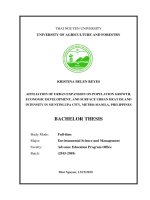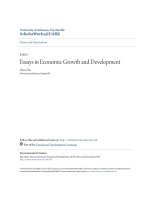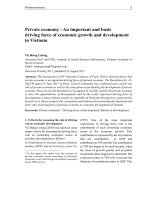Economic growth and economic development 712
Bạn đang xem bản rút gọn của tài liệu. Xem và tải ngay bản đầy đủ của tài liệu tại đây (107.08 KB, 1 trang )
Introduction to Modern Economic Growth
Recent work by Allen (2005) argues for the importance of the Habakkuk hypothesis for understanding the British Industrial Revolution. Exercise 15.20 shows how
models of directed technological change can clarify the conditions necessary for this
hypothesis to apply.
15.10. Exercises
Exercise 15.1. Derive equation (15.1).
Exercise 15.2. Complete the proof of Proposition 15.1. In particular, verify that
in any BGP, (15.27) must hold and derive the equilibrium growth rate as given by
(15.29). Also prove that (15.28) ensures that the two free entry conditions (15.20)
and (15.21) must hold as equalities. Finally, check that this condition is also sufficient to guarantee that the transversality condition is satisfied. [Hint: calculate the
equilibrium interest rate and then use (15.22)].
Exercise 15.3. Prove Proposition 15.2. [Hint: use (15.9) to show that when
NH (0) /NL (0) does not satisfy (15.27), (15.20) and (15.21) cannot both hold as
equalities].
Exercise 15.4. Derive equation 15.30.
Exercise 15.5. Explain why in Proposition 15.1 the effect of γ on the BGP growth
rate, (15.29), is ambiguous. When is this effect positive? Provide an intuition.
Exercise 15.6. Derive equation 15.31.
Exercise 15.7. Prove Proposition 15.5. [Hint: first substitute for C (t) from the
constraint. Then show that µH (t) /µL (t) = (η H (t) /η L (t))−1 . Then use the necessary conditions with µ˙ H (t) = µ˙ L (t)].
Exercise 15.8. Derive the free entry conditions (15.34) and (15.35). Provide an
intuition for these conditions.
Exercise 15.9. Derive equation (15.37).
Exercise 15.10. Prove Proposition 15.6. In particular, check that there is a unique
BGP and that the BGP growth rate satisfies the transversality condition.
Exercise 15.11. In the model of Section 15.4, show that an increase in η H will raise
∗
,
the number of scientists working in H-complementary technologies in the BGP, SH
when σ > 1 (and σ < 1/δ) and reduce it when σ < 1. Interpret this result.
698









